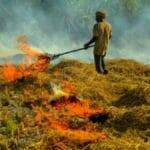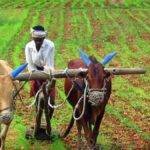Main Points In Hindi (मुख्य बातें – हिंदी में)
-
डीएपी की कमी: कृषि मंत्री एक सम्मेलन की अध्यक्षता कर रहे हैं, जिसमें रबी फसलों के लिए रणनीतियाँ बनायी जाएंगी। इस दौरान, डि-अमोनियम फॉस्फेट (डीएपी) की कमी एक महत्वपूर्ण मुद्दा है, जो प्रमुख उर्वरक है।
-
बिक्री में गिरावट: हालिया आंकड़ों के अनुसार, पिछले महीने डीएपी की बिक्री 7.76 लाख टन रही, जो पिछले साल की 15.7 लाख टन की बिक्री से 51% कम है, जो किसानों के लिए चिंताजनक है।
-
फसल की तैयारी: किसान आमतौर पर सितंबर-अक्टूबर में बुआई के लिए डीएपी खरीदते हैं। इस साल मौसम अनुकूल होने की उम्मीद है, लेकिन डीएपी की कमी की वजह से किसानों में असंतोष उत्पन्न हो गया है, विशेष रूप से पंजाब और मध्य प्रदेश में।
-
सरकार की भूमिका: कृषि वैज्ञानिक एके सिंह ने बताया कि सरकार को गेहूं की फसल की उचित उपलब्धता सुनिश्चित करनी चाहिए और पिछले वर्षों के अनुभव के आधार पर खरीफ फसल की निगरानी करने की आवश्यकता है।
- उर्वरक बिक्री में अंतर: अन्य उर्वरकों के मुकाबले डीएपी में बिक्री में गिरावट देखी गई है, जबकि यूरिया की बिक्री में 3.1% की वृद्धि हुई है, जिससे यह स्पष्ट होता है कि डीएपी की मांग का सही प्रबंधन होना चाहिए।
Main Points In English(मुख्य बातें – अंग्रेज़ी में)
Here are the main points from the article regarding the decline in DAP (Di-Ammonium Phosphate) sales and its implications for agriculture:
-
Significant Drop in DAP Sales: DAP sales fell sharply by 51% in September, dropping to 7.76 lakh tonnes from 15.7 lakh tonnes a year earlier, raising concerns among farmers who depend on this key fertilizer for winter crops like wheat, mustard, and chickpeas.
-
Impact on Farmers: Farmers typically purchase DAP in September and October to prepare for sowing. Reports indicate dissatisfaction and protests from farmers, particularly in states like Punjab and Madhya Pradesh, regarding the availability of DAP.
-
Need for Government Action: Agricultural experts have emphasized the importance of ensuring the timely and sufficient availability of DAP to prevent risks, particularly highlighting the critical nature of the upcoming wheat crop.
-
Overall Fertilizer Sales Data: The report also mentions that while DAP sales have fallen, sales of other fertilizers like urea have seen an increase. For instance, urea sales rose 3.1% in September, which contrasts with DAP’s decline.
- Future Strategies: The government is set to discuss strategies with state officials related to the upcoming Rabi sowing season, aiming to meet production targets for essential crops and to manage the availability of fertilizers effectively for the winter planting season.


Complete News In Hindi(पूरी खबर – हिंदी में)
चूंकि कृषि मंत्री शनिवार को रबी फसलों पर वार्षिक सम्मेलन की अध्यक्षता कर रहे हैं, जहां बंपर फसल के लिए राज्यों के साथ रणनीति तैयार की जाएगी, ध्यान आकर्षित करने वाला एक महत्वपूर्ण मुद्दा डि-अमोनियम फॉस्फेट (डीएपी) की कमी हो सकता है, जो प्रमुख उर्वरक है। गेहूं, सरसों और चना, तीनों प्रमुख शीतकालीन फसलें।
नवीनतम आंकड़ों से पता चलता है कि डीएपी की बिक्री पिछले महीने गिरकर 7.76 लाख टन (लीटर) हो गई, जो कि एक साल पहले के 15.7 लाख टन से 51 प्रतिशत कम है। सितंबर में डीएपी की मासिक बिक्री 2022 में 11.15 लीटर, 2021 में 5.96 लीटर, 2020 में 7.65 लीटर और 2019 में 6.33 लीटर दर्ज की गई।
“किसान आमतौर पर बुआई के लिए खेत तैयार करने के लिए सितंबर-अक्टूबर में डीएपी खरीदते हैं। कृषि वैज्ञानिक एके सिंह ने कहा, अनुकूल मानसून और इसकी देरी से वापसी के साथ-साथ अच्छी नमी के कारण उर्वरकों की मांग बढ़ गई है क्योंकि किसानों को सर्दियों की फसलों की अच्छी फसल की उम्मीद है।
-
यह भी पढ़ें: भारत ने चावल निर्यात प्रतिबंधों में और ढील देने का फैसला किया
सिंह ने कहा कि विशेष रूप से पंजाब, मध्य प्रदेश से डीएपी की कथित कमी को लेकर किसानों के विरोध की खबरें आ रही हैं, जहां तक उपलब्धता का सवाल है, कुछ गड़बड़ है।
सिंह ने सुझाव दिया, “इस साल गेहूं की फसल बहुत महत्वपूर्ण है और सरकार को कोई जोखिम नहीं लेना चाहिए और पर्याप्त और समय पर उपलब्धता सुनिश्चित करनी चाहिए।” उन्होंने कहा कि गेहूं की सिकुड़ी हुई फसल पर अध्ययन होना चाहिए, जो पिछले कुछ वर्षों से जारी है और सरकार किसी न किसी राज्य में खरीद मानदंडों में ढील दी जा रही है।
फसल मौसम निगरानी रिपोर्ट के अनुसार, खरीफ सीजन 2024 (अप्रैल-सितंबर) के दौरान कुल उर्वरक बिक्री 319.97 लीटर थी जिसमें 189.12 लीटर यूरिया, 46.12 लीटर डीएपी, 9.27 लीटर एमओपी और 75.46 लीटर कॉम्प्लेक्स (एन का मिश्रण) शामिल था। , पी , के पोषक तत्व)। सीज़न की कुल मांग 321.44 लीटर अनुमानित थी – 177.12 लीटर यूरिया, 59.87 लीटर डीएपी, 10.26 लीटर एमओपी और 74.19 लीटर कॉम्प्लेक्स।
सिंह ने कहा कि अनुमानित मांग के मुकाबले डीएपी की बिक्री में गिरावट देखना असामान्य है, जबकि मांग के साथ बिक्री के आंकड़ों की तुलना करने पर अन्य उर्वरकों में ऐसा कोई अंतर नहीं देखा गया है।
आधिकारिक आंकड़ों से पता चलता है कि सितंबर 2024 में यूरिया की बिक्री 3.1 प्रतिशत बढ़कर 30.89 लीटर हो गई, जो एक साल पहले 29.97 लीटर थी, लेकिन एमओपी की बिक्री 2.36 लीटर से 4.7 प्रतिशत कम होकर 2.25 लीटर और कॉम्प्लेक्स 11.6 प्रतिशत गिरकर 16.6 लीटर रह गई। 18.77 लीटर से.
केंद्र 1 अक्टूबर से शुरू होने वाले रबी बुआई सीजन के बारे में योजना और रणनीतियों के बारे में राज्य के अधिकारियों के साथ (19 अक्टूबर को) चर्चा करेगा, ताकि यह सुनिश्चित किया जा सके कि सर्दियों में उगाए जाने वाले खाद्यान्न उत्पादन का लक्ष्य 115 सहित 164 मिलियन टन (एमटी) है। अधिकारियों ने कहा, एमटी गेहूं, 13.65 मिलियन टन चना और 13.8 मिलियन टन सरसों।
-
यह भी पढ़ें: पहली छमाही में चावल का निर्यात थोड़ा कम हुआ, लेकिन सरकार द्वारा प्रतिबंधों में ढील दिए जाने से आने वाले वर्ष में व्यापार में शिपमेंट में तेजी देखी जा रही है।
Complete News In English(पूरी खबर – अंग्रेज़ी में)
Since the Agriculture Minister is chairing the annual conference on Rabi crops on Saturday, where strategies will be developed with states for a bumper harvest, a significant issue attracting attention might be the shortage of diammonium phosphate (DAP), a key fertilizer for wheat, mustard, and chickpeas—three major winter crops.
Recent data shows that DAP sales fell to 776,000 tonnes (liters) last month, a 51% decline from 1.57 million tonnes the previous year. In September, DAP sales were recorded at 1.115 million liters in 2022, 596,000 liters in 2021, 765,000 liters in 2020, and 633,000 liters in 2019.
Farmers typically buy DAP in September and October to prepare their fields for sowing. Agricultural scientist A.K. Singh mentioned that the demand for fertilizers has increased due to favorable monsoon conditions, which bring hope for a good winter crop yield.


Reports indicate that especially in Punjab and Madhya Pradesh, farmers are protesting the alleged shortage of DAP, raising concerns about availability.
Singh emphasized that the wheat crop is very important this year, urging the government to ensure sufficient and timely availability of fertilizers to avoid any risks. He also suggested that a study should be conducted on the declining wheat yield observed over the years, noting that there have been relaxations in procurement criteria in some states.
According to the crop monitoring report, total fertilizer sales during the Kharif season 2024 (April-September) were 3.20 million liters, which included 1.89 million liters of urea, 461,200 liters of DAP, 92,700 liters of MOP, and 754,600 liters of complex fertilizers. The total estimated demand for the season was 3.21 million liters.
Singh remarked that the decline in DAP sales compared to the estimated demand is unusual, as sales figures for other fertilizers do not show such a significant difference.
Official data shows that urea sales in September 2024 increased by 3.1% to 3.089 million liters, compared to 2.997 million liters the previous year. However, MOP sales fell by 4.7% to 225,000 liters, and complex fertilizer sales dropped by 11.6% to 1.66 million liters from 1.877 million liters.
The central government plans to discuss strategies for the Rabi sowing season, starting on October 1, with state officials on October 19, aiming to meet a production target of 164 million tonnes (MT) for wheat, along with 13.65 million tonnes of chickpeas and 13.8 million tonnes of mustard.
Published on October 18, 2024.
Source link








